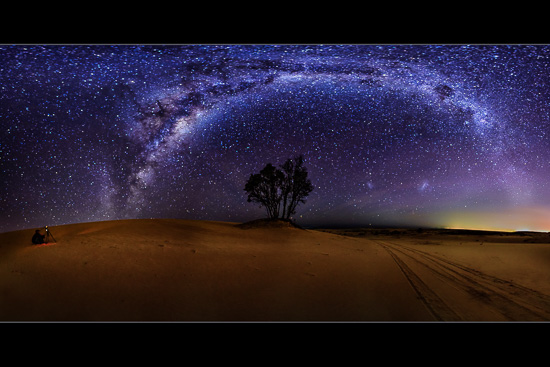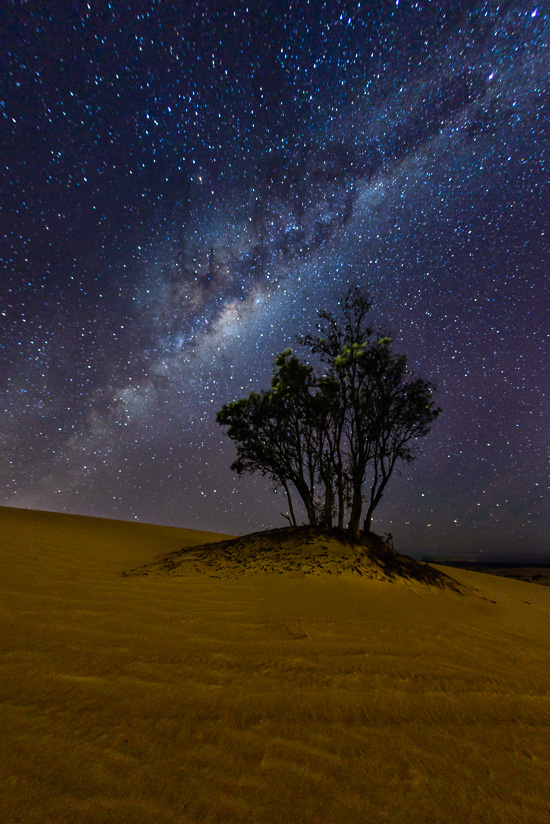Astro – Panorama @ Stockton Dunes…
by Rodney Campbell on Jul.18, 2014, under Life, Photography
The Astro Photographer craves the night – and not just any night – they desire the lowest of low lights. They search out dark skies, requiring moonless cloudless evenings far away from cities and light pollution. Huddled alone in the dark with camera pointed up into the vastness of the universe seeking out those faint points of light in the skies
A stitched panorama consisting of six (6) fisheye frames shot at 25 sec @ f/2.8 and ISO 3200
Alone with the Universe
The sky was incredibly clear now with the whole span of the milky way visible in the sky above
Pro Tip: For astro work you want to use a fast (wide aperture) lens basically because with very dim stars you want to let in as much light into the camera as you possibly can – this both allows you to use a lower ISO (allowing cleaner less noisy images) and a short enough shutter speed so that the stars appear sharp in the image (without trailing)
Pro Tip: When selecting the shutter speed to use for single static star (starfield) images you can use what is known as the 500 rule – basically divide 500 by the full frame equivalent focal length of your lens and that represents the maximum shutter speed you should use to avoid having trailing starts in your images and instead having point stars. e.g. when using a 16mm lens this leads to 500/16 = 31.25 (so I kept my shutter speeds under 31 seconds before), with the 35mm lens I’d have to stay under 500/35 = 14.3
I had the 16-35 f/4 (which I used for the earlier shots but it’s not really fast enough – you really want to use f/2.8 or faster), the 24-70 f/2.8 and the 35 f/1.4 (which I was originally intending on doing a massive multi row starfield panorama with
The 35/1.4 is an ideal astro lens because it’s really fast (1.4 aperture) and relatively wide (the 24/1.4 would be better but it’s a > $2.5K lens), it’s also quite sharp wide open
The 35mm would however have taken an insane number of rows of images to cover over 180º field of view of the span of the milky way overhead, it would have been massively painstaking given I didn’t have a multi row pano head – but it would have resulted in a very sharp and highly detailed gigapixel image if it worked 🙂
Personally I would have liked to have had the Rokinon/Bower/Samyang 14mm f/2.8 (or the much more expensive Nikon 14-24/2.8) but alas…
See the following excellent guide if you would like to know more about How to Pick a Lens for Milky Way Photography
In the bitter cold I wasn’t up for the time and effort required for this so opted instead to use the Sigma 15mm f/2.8 fisheye – basically because it’s the only other fast (aperture) wide lens I had brought and it has a massive field of view so I wouldn’t need to take very many frames. I just winged the frames (since I couldn’t see anything in the viewfinder) and hoped I’d get enough overlap and a half decent level whilst pointing angled up towards the sky
I got close to the tree so it would be reasonably large in the frame and placed myself so that the milky way would appear to arch over the tree and spread over to where the horrible light pollution was (that’s the city of Newcastle by the way), and also hopefully have the 4WD drive tracks that were already there in the sand leading off from around the corner of the frame
The Sigma 15mm fisheye is very nicely wide – tick, and it’s f/2.8 maximum aperture is pretty fast – tick, but wide open it unfortunately isn’t the sharpest tool in the shed – especially when you get near the edges and the distortion (it’s a fisheye after all) is pretty intense. This all makes for pretty interesting stitching results but I was pretty happy with my first attempt at a panorama starfield of the milky way, I’ve even managed to get Suren there happily shooting the stars
To end our evening on Stockton dunes a single vertical shot of the tree from even closer with the milky way above – and for this one I’ve let Lightroom’s lens correction profile for the lens do it’s work
Heavens Above
It was only just after 8PM but we were cold and hungry (very very cold) so it was time to walk back out and head to nearby Nelson Bay for some well earned dinner…








